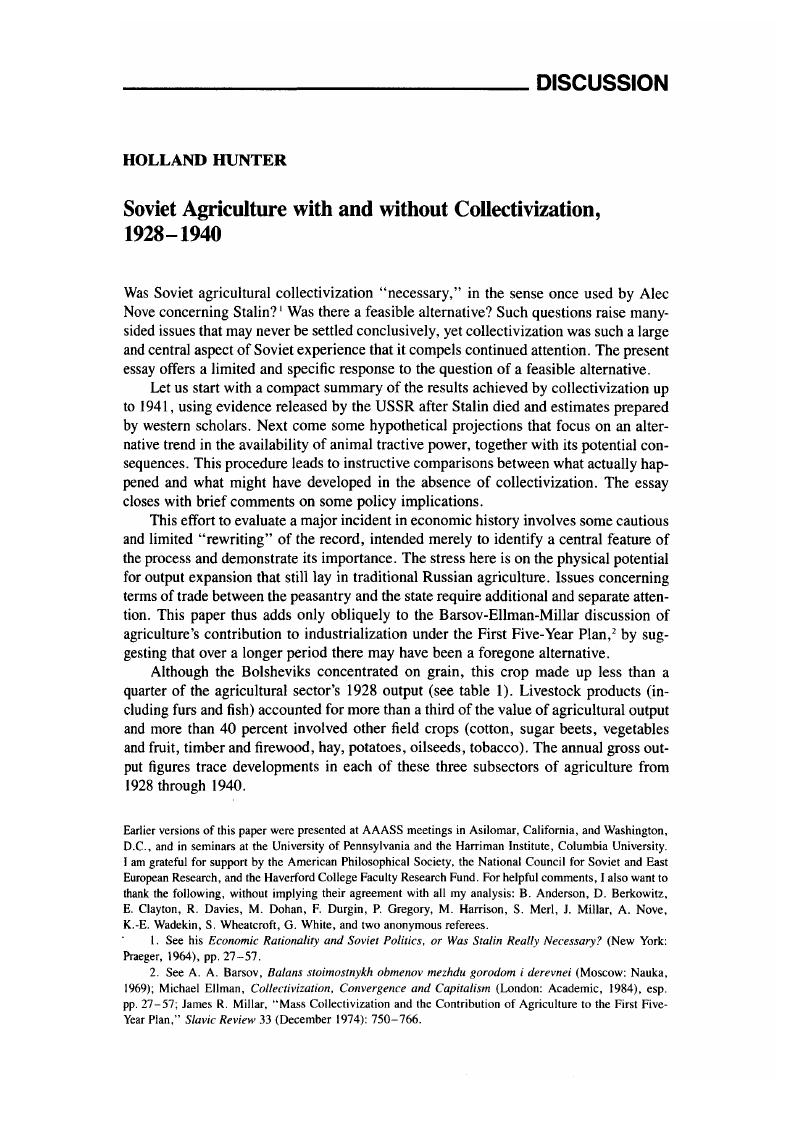Article contents
Soviet Agriculture with and without Collectivization, 1928-1940
Published online by Cambridge University Press: 27 January 2017
Abstract

- Type
- Discussion
- Information
- Copyright
- Copyright © Association for Slavic, East European, and Eurasian Studies. 1988
References
1. See his Economic Rationality and Soviet Politics, or Was Stalin Really Necessary? (New York: Praeger, 1964), pp. 27–57.
2. See Barsov, A. A., Balans stoimostnykh obmenov mezhdu gorodom i derevnei (Moscow: Nauka, 1969 Google Scholar; Ellman, Michael, Collectivization, Convergence and Capitalism (London: Academic, 1984), esp.pp. 27–57 Google Scholar; Millar , James R., “Mass Collectivization and the Contribution of Agriculture to the First Five-Year Plan,” Slavic Review 33 (December 1974): 750–766.CrossRefGoogle Scholar
3. Naum Jasny, The Socialized Agriculture of the USSR (Stanford, Calif.: Stanford University Press, 1949), p. 204.
4. Davies, R. W., The Collectivization of Soviet Agriculture, 1929–1930 (Cambridge: Harvard UniversityPress, 1980), pp. 22–23.Google Scholar
5. Jasny, Socialized Agriculture, p. 214.
6. See Karcz, Jerzy F., The Economics of Communist Agriculture, ed., Wright, Arthur W. (Bloomington, Ind.: International Development Institute, 1979), esp. pp. 47, 339–340, 417–419.Google Scholar
7. See the series carefully derived by Paul R. Gregory from primary evidence and the research of A. L. Vainshtein, in Appendix H, Gregory, Paul, Russian National Income, 1885–1913 (Cambridge: Cambridge University Press, 1982), pp. 265–220.Google Scholar
8. Detailed data on the number of horses in the USSR are available from the Gosplan SSSR volume, Kontrol'nye tsifry narodnoe khoziaistvo SSSR na 1929–30 god (Moscow: lzdatel'stvo Plan. Khoz., 1930), pp. 530–531.
9. For the 1940 sown area in pre-1939 territory, see Akademiia Nauk SSSR, Institut Ekonomiki, Sotsialisticheskoe narodnoe khoziaistvo SSSR v 1933–1940 gg. (Moscow: AN SSSR, 1963), p. 472 Google Scholar; other data from TsSU, Sel'skoe khoziaistvo SSSR (Moscow: Gosstatizdat TsSU, 1960), p. 127.
10. See Gale Johnson, D. and Kahan, Arcadius, “Soviet Agriculture: Structure and Growth,” in U.S.Congress, Joint Economic Committee, Comparison of the United States and Soviet Economies (Washington, D.C.: Government Printing Office, 1959), p. 211.Google Scholar
11. Davies, Collectivization of Soviet Agriculture, p. 10.
12. Jasny, Socialized Agriculture, p. 508.
13. See Stephan Merl, “Handlungsspielräume und Sachzwange in der sowjetischen Wirtschafts und Sozialpolitik der Zwischenkriegszeit,” pp. 175–229, in Sachzwange und Handlungsspielräume in der Wirtschafts- und Sozialpolitik der Zwischenkriegszeit (Berlin: Wolfram Fischer, 1985), esp. p. 214.
14. AN SSSR, Sotsialisticheskoe narodnoe khoziaistvo 1933–1940, p. 475, citing Istoriia velikoi otechestvennoi voiny Sovetskogo Soiuza 1941–1945 gg. (1960) 1: 412.
- 12
- Cited by




